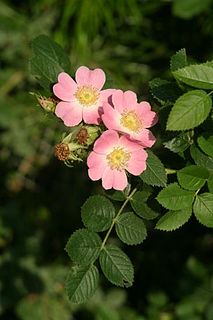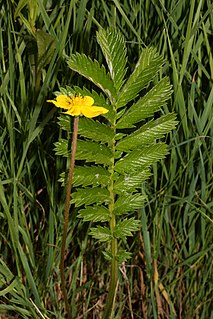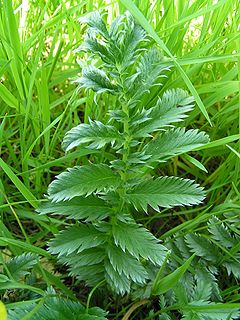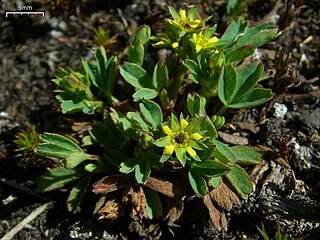
Rosaceae, the rose family, is a medium-sized family of flowering plants that includes 4,828 known species in 91 genera.

The rose subfamily Rosoideae consists of more than 850 species, including many shrubs, perennial herbs, and fruit plants such as strawberries and brambles. Only a few are annual herbs.

Potentilla is a genus containing over 300 species of annual, biennial and perennial herbaceous flowering plants in the rose family, Rosaceae.

Dryas is a genus of perennial cushion-forming evergreen dwarf shrubs in the family Rosaceae, native to the arctic and alpine regions of Europe, Asia and North America. The genus is named after the dryads, the tree nymphs of ancient Greek mythology. The classification of Dryas within the Rosaceae has been unclear. The genus was formerly placed in the subfamily Rosoideae, but is now placed in subfamily Dryadoideae.

Argentina anserina is a perennial flowering plant in the rose family, Rosaceae. It is known by the common names silverweed, common silverweed or silver cinquefoil. It is native throughout the temperate Northern Hemisphere, often on river shores and in grassy habitats such as meadows and road-sides. The plant was originally placed in the genus Potentilla by Carl Linnaeus in his Species plantarum, edition 1, (1753) but was reclassified into the resurrected genus Argentina by research conducted in the 1990s. The reclassification remains controversial and is not accepted by some authorities. It is a species aggregate which has frequently been divided into multiple species.

Dasiphora fruticosa is a species of hardy deciduous flowering shrub in the family Rosaceae, native to the cool temperate and subarctic regions of the northern hemisphere, often growing at high altitudes in mountains. Dasiphora fruticosa is still widely referenced in the horticultural literature under its synonym Potentilla fruticosa. Common names include shrubby cinquefoil, golden hardhack, bush cinquefoil, shrubby five-finger, widdy, and kuril tea.

Elaeagnus, silverberry or oleaster, is a genus of about 50–70 species of flowering plants in the family Elaeagnaceae.

Argentina (silverweeds) is a genus of plants in the rose family (Rosaceae) which is accepted by some authors, as containing 64 species, but classified in Potentilla sect. Leptostylae by others.

Sibbaldiopsis is a genus in the plant family Rosaceae. This genus only contains a single species: Sibbaldiopsis tridentata, formerly Potentilla tridentata. Commonly, its names include three-toothed cinquefoil, shrubby fivefingers, and wineleaf. Systemic phylogenetic work has placed S. tridentata within Sibbaldia as Sibbaldia retusa.

Salsola is a genus of the subfamily Salsoloideae in the family Amaranthaceae. The genus sensu stricto is distributed in central and southwestern Asia, North Africa, and the Mediterranean. A common name of various members of this genus and related genera is saltwort, for their salt tolerance. The genus name Salsola is from the Latin salsus, meaning "salty".

Drymocallis is a genus of plants formerly included with the typical cinquefoils (Potentilla). It contains three species known or suspected to be protocarnivorous, but more cinquefoils might eventually be moved here:
P. fruticosa may refer to:
Potentilla johnstonii is a rare species of flowering plant in the rose family known by the common name sagebrush cinquefoil. It is native to Nevada, where it has been collected from only one spot in the Quinn Canyon Range of Nye County.
Primula capillaris is a rare species of flowering plant in the primrose family known by the common name Ruby Mountains primrose, or Ruby Mountain primrose. It is endemic to Nevada in the United States, where it is limited to the Ruby Mountains of Elko County.

Sibbaldianthe bifurca is a species of flowering plant in the family Rosaceae which can be found in Russian, Korean, and Mongolian steppes, grasslands and various slopes on an elevation of 400–4,000 metres (1,300–13,100 ft). It is also found on sandy coasts of North and Northeast China. It was described by Carl Linnaeus in 1753 in his book Species Plantarum as Potentilla bifurca.

Sibbaldia is a genus of flowering plants of the family Rosaceae, with a circumpolar distribution, including the high Arctic. Most of the species are found in the Himalaya. The type species is Sibbaldia procumbens. It is also in the Rosoideae subfamily.
Sibbaldianthe is a genus of flowering plants belonging to the family Rosaceae. It is also in the Rosoideae subfamily.

Potentilla aurea, the golden cinquefoil, is a species of flowering plant in the family Rosaceae. It is native to the mountains of mainland Europe, and has been introduced to Turkey. A number of cultivars are available, including 'Aurantiaca', 'Goldklumpen', and 'Plena'.














